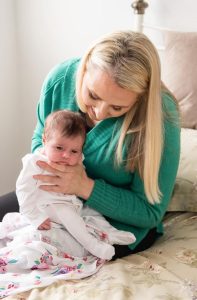Type of vaccine
Combination inactivated vaccine
Protects against
Whooping cough
Primary course
3 doses
Boosters
1
Suitable for ages
From 6 weeks
What is the whooping cough vaccine?
Whooping cough (also known as “Pertussis”) is a highly contagious bacterial infection that can cause a long-lasting and persistent cough and often results in a deep intake of breath between coughing that causes the distinct ‘whoop’ sound.
This illness can affect people of all ages but is most serious in infants under 12 months.
Protection is offered through a combination vaccine for diphtheria, tetanus and whooping cough. The smallest combination vaccine available containing whooping cough is the 3-in-1 DTaP. There are also 4-in-1 and 5-in-1 vaccine combinations available.
Other vaccines include protection against pertussis but these are most often used as a booster injection rather than for the primary course of vaccination.
How does the whooping cough vaccine work?
The bacteria that cause whooping cough make several harmful proteins known as toxins. Having an immune response (the ability to recognise and fight these toxins) helps to protect children from the illness.
The whooping cough component of the DTaP vaccine is “acellular” (this is what the lowercase “a” stands for) and means that it contains cellular material but not whole cells.
Essentially, the vaccine contains cellular material from two to five of the pertussis toxins that have been inactivated to turn them from toxins into “toxoids”. As toxoids, they elicit an immune response without being able to cause whooping cough.
Whooping cough vaccine FAQs
Whooping cough vaccine ingredients
On the tabs below, you will find ingredient information and links to the Patient Information Leaflets for the UK standard vaccines that protect against whooping cough. Other suitable vaccines may be available for your child based on the clinical need, but this must be discussed during a consultation to ensure you are given the appropriate advice and prescription for your child’s needs.
Name: Infanrix-IPV+Hib (5-in-1 DTaP, IPV & Hib vaccine)
Age: Suitable from age six weeks to three years
Manufacturer: GlaxoSmithKline
Protects against: Diphtheria, tetanus, whooping cough, IPV & Hib
Active ingredients: Not less than 30IU diphtheria toxoid, not less than 40IU tetanus toxoid, 25μg pertussis toxoid, 25μg filamentous haemagglutinin, 8μg pertactin, 40 D antigen units poliovirus type 1, 8 D antigen units poliovirus type 2, 32 D antigen units poliovirus type 3, 10μg HIB capsular polysaccharide
Other ingredients: 25μg tetanus toxoid (as conjugate), lactose, sodium chloride, Medium 199 (containing amino acids (including phenylalanine*), mineral salts (including sodium and potassium), vitamins (including para-aminobenzoic acid) and other substances), water for injections
The vaccine may contain traces of formaldehyde, neomycin and polymyxin which are used during the manufacturing process
It contains para-aminobenzoic acid <0.07 nanograms per dose and phenylalanine 0.036 micrograms per dose
* Phenylalanine may be harmful if you have phenylketonuria (PKU), a rare genetic disorder in which phenylalanine builds up because the body cannot remove it properly.
Mercury content: Nil
Aluminium content: 0.5mg**
** Some manufacturers’ leaflets reference the amount of the aluminium compound (e.g. aluminium hydroxide), whereas we have calculated the amount of elemental aluminium within the compound
Contains porcine gelatin?: No
Contains dairy products?: Yes
Licensed for use in the UK
Infanrix-IPV+Hib Patient Information Leaflet: Click to view
Age: Suitable from age six weeks up to 15 months (however, NHS England recommends it for up to 10 years of age for those with incomplete vaccination status)
Manufacturer: Sanofi Pasteur
Protects against: Diphtheria, tetanus, whooping cough, hepatitis B, polio & Hib
Active ingredients: Each 0.5 mL dose contains not less than 20IU diphtheria toxoid, not less than 40 IU tetanus toxoid, Bordetella pertussis antigens [20 mcg pertussis toxiod (PT), 20 mcg filamentous hemagglutinin (FHA), 3 mcg pertactin (PRN), and 5 mcg fimbriae types 2 and 3 (FIM)], 10mcg Hepatitis B surface antigen, Poliovirus (Inactivated) [Type 1 (Mahoney) 40 D antigen units, Type 2 (MEF-1) 8 D antigen units, Type 3 (Saukett) 32 D antigen units], Haemophilus influenzae type B polysaccharide [3 mcg Polyribosylribitol phosphate, 50mcg conjugated to meningococcal protein]
Other ingredients: Sodium phosphate, water for injections
* Aluminium phosphate and amorphus aluminium hydroxyphosphate sulphate are included in the vaccine as adjuvants. The vaccine may also contain traces of glutaraldehyde, formaldehyde, neomycin, streptomycin, polymyxin B, and bovine serum albumin
Mercury content: Nil
Aluminium content: 0.32mg*
* Some manufacturers’ leaflets reference the amount of the aluminium compound (e.g. aluminium hydroxide), whereas we have calculated the amount of elemental aluminium within the compound
Contains porcine gelatin?: No
Contains dairy products?: No
Licensed for use in the UK
Vaxelis Patient Information Leaflet: Click to view
Name: Boostrix-IPV (4-in-1 dTap-IPV) (low doses of diphtheria, pertussis, tetanus and polio vaccine)
Age: From age three and upwards
Manufacturer: GlaxoSmithKline
Protects against: Diphtheria, tetanus, whooping cough & polio
Active ingredients: 2IU* diphtheria toxoid, 20IU tetanus toxoid, 8µg pertussis toxoid, 8µg filamentous haemagglutinin, 2.5µg pertactin; Inactivated poliovirus – type 1 (Mahoney strain), 40 D-antigen unit type 2 (MEF-1 strain), 8 D-antigen unit type 3 (Saukett strain), 32 D-antigen unit
*International units
Other ingredients: Medium 199 (containing amino acids (including phenylalanine**), mineral salts (including sodium and potassium), vitamins (including para-aminobenzoic acid) and other substances), sodium chloride and water for injections
** Boostrix-IPV contains phenylalanine which may be harmful to people with phenylketonuria (PKU)
Mercury content: Nil
Aluminium content: 0.5mg***
*** Some manufacturers’ leaflets reference the amount of the aluminium compound (e.g. aluminium hydroxide), whereas we have calculated the amount of elemental aluminium within the compound
Contains porcine gelatin?: No
Contains dairy products?: No
Licensed for use in the UK
Boostrix-IPV Patient Information Leaflet: Click to view
Name: Repevax (4-in-1 Tdap vaccine with IPV)
Age: Suitable from age three
Manufacturer: Sanofi Pasteur
Protects against: Tetanus, diphtheria, whooping cough & polio
Active ingredients: Diphtheria Toxoid (not less than 2 International Units (2 Lf)); Tetanus Toxoid (not less than 20 International Units (5 Lf)); Pertussis Antigens: Pertussis Toxoid 2.5 micrograms, Filamentous Haemagglutinin 5 micrograms, Pertactin 3 micrograms, Fimbriae Types 2 and 3 5 micrograms; Inactivated Poliomyelitis Virus (produced in Vero cells): Type 1 (Mahoney) 40 D antigen units, Type 2 (MEF1) 8 D antigen units, Type 3 (Saukett) 32 D antigen units
Other ingredients: Phenoxyethanol, ethanol, polysorbate 80, water for injections
REPEVAX may contain traces of formaldehyde, glutaraldehyde, streptomycin, neomycin, polymyxin B and bovine serum albumin
Mercury content: Nil
Aluminium content: 0.33 mg*
* Some manufacturers’ leaflets reference the amount of the aluminium compound (e.g. aluminium hydroxide), whereas we have calculated the amount of elemental aluminium within the compound
Contains porcine gelatin?: No
Contains dairy products?: No
Licensed for use in the UK
Repevax Patient Information Leaflet: Click to view
Aftercare
We’ll give you detailed aftercare advice for your child after their vaccination(s), including what to do in the event of any side effects.
Your child may experience some redness, tenderness and/or swelling at the injection site, so it’s helpful to expect this. These side effects should self-resolve within a few days.
You can download our Patient Aftercare leaflet here.
If your child is unwell outside of clinic hours, please call 111 for advice or go to A&E if they need urgent medical attention.



